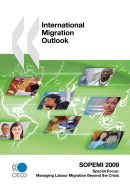
Across Europe, most migrant groups have lower
employment rates, and a greater tendency to be overqualified for their
jobs, than non-migrants. This report considers how European economies
could benefit from the underutilised skills of their migrant
populations.
Despite increased flows of foreign-born workers over the last
decade, there remain important discrepancies between the employment
outcomes of migrants and non-migrants across Europe. These
discrepancies represent significant losses of potential and talent, and
have negative impacts not only on migrants themselves but by the
European economy as a whole.This report presents new statistical analyses of European labour markets in order to identify where, how and to what extent migrants are underutilised, relative to the non-migrant population, in terms of either a low employment rate or a misallocation of skills. Surveying the picture across Europe, it also focusses on a set of illuminating contrasts between the labour markets and populations of Britain and Germany with regards to levels of education, skills and employment.
We consider the interactions of a complex set of dynamics arising from issues related to gender, discrimination, migration routes, labour market structures, employment rights and professional and social networks. We find that collectively, these factors contribute not only to a lack of inclusivity in the high-skill jobs market, but to higher concentrations of some migrant groups in lower-skill sectors of the economy. This is leading to a growing misallocation of skills: overqualification is on the rise, particularly among migrants, a phenomenon that must be addressed, particularly in the context of growing skills gaps in many European economies.
By examining the employment characteristics of different migrant groups across EU labour markets, we identify some of the obstacles and challenges that policymakers will need to resolve in order to reverse the underutilisation of these groups’ skills, as part of broader strategies to improve skills allocation and economic output across Europe. Among our findings are that:
- the difference between the employment rates of tertiary-educated migrants and non-migrants is larger than the gap between migrants and non-migrants within any other qualification group
- non-EU migrants have lower employment rates than non-migrants, regardless of their qualification level
- the UK is an outlier in Europe, in the sense that only there do migrants from within the EU have higher employment rates than non-migrants
- relatively low employment rates among non-EU migrants in both Germany and the UK can be almost entirely accounted for by relatively low employment rates among migrant women
- the concentration of certain nationality groups in specific (low-skill) sectors of the economy is higher in the UK than in Germany, as is overqualification among tertiary-educated migrants.



















Nessun commento:
Posta un commento